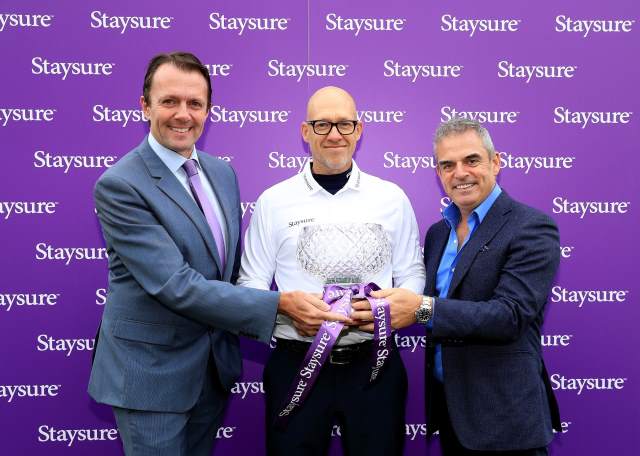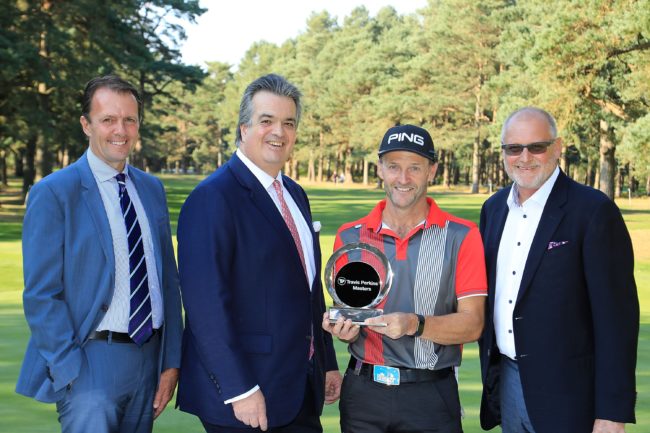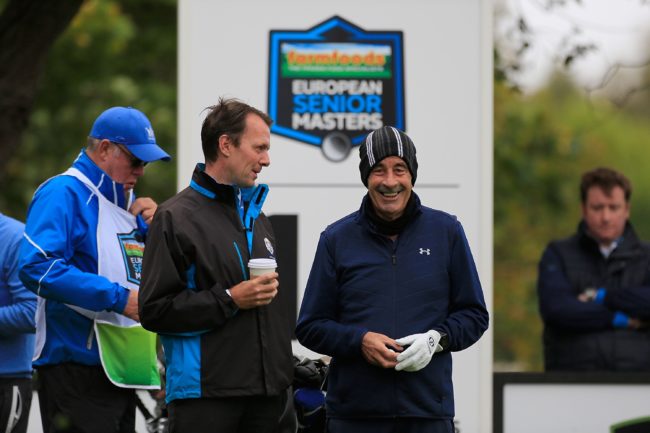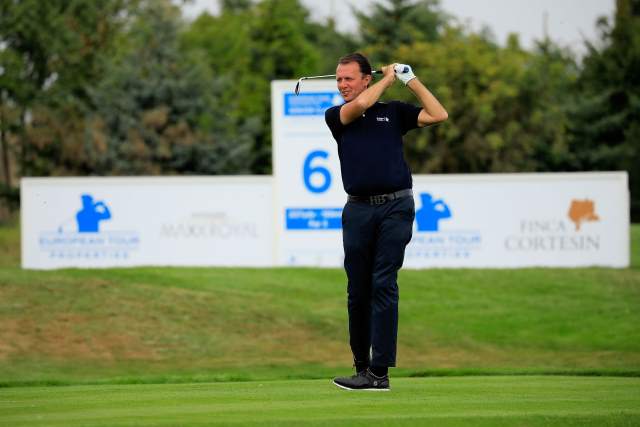As the first season of the Staysure Tour reaches its final weeks, the Tour’s boss David MacLaren sat down with GBN contributor Ross Biddiscombe. The interview marks MacLaren’s two and a year anniversary of heading up the Tour and answers how he also manages his other job as Head of European Tour Properties.

Q: What is the Staysure Tour’s success based on?
A: If you look at the reasons why the Staysure Tour exists and has flourished, both now and at different times in its previous history, you have to look at how do you create a commercially sustainable model for a group of over 50s golfers. That might sound distant and a little difficult, but if you look at the USPs that we’ve got, then it looks significant and it starts and stops with the players themselves. When I’m out there with my sales tool kit, then what the players give back is the most powerful thing I have. For the traditional golfers who are our core market, the opportunity to watch and interact with Woosie or Costantino (Rocca) is something special. It doesn’t make us better than, for example, the Challenge Tour, but it’s about those names who resonate with our core audience.
Q: But you’ve also created more tournaments and that must help, yes?
A: Players will and do play in up to two pre-tournament pro-ams and attend the pro-am dinners and most of our tournaments have an alliance format where our pros play with an amateur in the first two rounds. That’s a lot to ask, but it’s a key way to save the Tour and re-build it by focusing on the things that make it special. The public has such a choice of things to do, so how on earth do you market a sporting product whose core constituency is old golfers. But when you look at what you’ve got to market, ie the players, then these are guys with real personalities and pasts that they’re happy to share with people and their motivation is different.
Q: So what has your personal contribution been to the current state of the Tour?
A: That’s a good point. Firstly, there’s been much more of an unremitting focus on the interaction expected of the players over the last two years. The other thing is a quite commercial – to make sustainable tournaments for the sponsors and promoters. It seemed to me that it was better to have a tournament with a £250,000 prize fund than no tournament. So, if there’s one brave thing that we did, it was being prepared to reduce the cost of the tournament and the prize fund threshold to create a broader base to build on. Rather than charge what we believe the product is worth, then we charge what the market will pay. The Farmfoods European Senior Masters at Forest of Arden was a good example – one of the lowest prize funds on the Tour, but one of the highest quality fields based on the number of former Ryder Cup players. Our players want to play tournaments and whatever Tour you’re talking about, you have to operate in the marketplace. It’s better to build the credibility of the base rather than say we’re not interested because all our criteria aren’t met. One of the criticisms was that this would produce a kind of “race to the bottom” – all the loyal tournament supporters would ask why do I have a £350,000 prize fund when there are other events with less prize money and the same players. My answer was that a strong tour with lots of tournaments helps everyone and also there is a hope that every tournament will want to be as good as it can be. And that’s what’s happened. We’re playing for twice as much prize money than in 2015 and the players ranked from 1 to 60 have earned 15% to 30% more than last year.
Q: That’s not the European Tour strategy, but is that just the realism of a secondary tour?
A: It’s a strategy that works best for our product. The overall goal is to make the stakeholders more commercially successful, but we have done it in a different way to the main tour. In the strongest years of the Seniors Tour, we were up to 22 or 24 tournaments, but then it went down to 11 and now we’re up to 19. That curve is the only way to create progress and I perceived the marketplace that way. The next stage is to take the new tournaments and push them up. I can state to prospective tournaments that they will need £500,000 with half of that as prize money and the rest to pay for the staging and marketing costs. But you never know if you’d said it would cost £750,000 and they would pay that. But my judgement was that we had to pitch it at a level to create playing opportunities and that’s what led us to gaining a title sponsor. I can’t see that Staysure would’ve wanted a tour with just a few tournaments.
Q: Take me through that process of how you got together with Staysure.

A: When I started this job, Simon Harris, our commercial manager, said we’d had discussions about title sponsorship with a company called Staysure. I thought that was quite fanciful and my focus, as the new guy, was to create new tournaments. At the time, we switched our whole focus from securing sponsorships or partnerships to creating new tournaments. So, I said to Simon let’s think about this another time. He said the synergies are close because they sell travel insurance to an older market and specialise in people who have medical conditions. The feedback was that they were interested but were put off by the price. That became a recurring theme. But we used the same philosophy – look at what they wanted and figure out what they were prepared to pay. As discussions developed, Staysure were very interested and their chairman Ryan Howsam is an obsessive golfer, but their CEO Julian Kearney is not. It made for quite an interesting negotiation because Ryan is an ideas man and a very creative guy and they’re in a phase of huge growth, but Julian was the person who asked the most searching questions and we thought it wasn’t going to happen. It then became clear we could do a deal and it became very exciting.
We won’t disclose what the sponsorship is worth, but it’s a 10-year deal and maybe people think it’s a good deal or a bad one, but that’s irrelevant because it’s what a company is prepared to pay and to have them with all their synergies is great. What surprised me is how quickly and deeply the players have embraced the deal because it gives them confidence. The players generally don’t ask what Staysure are paying, but they now have a company that believes in them enough to invest in them. I was also desperately worried in how long it would take our small world to accept the change to a commercial name from a traditional name and a different logo and the new colour scheme of purple. But Keith Pelley said we must be sure the word ‘Staysure’ is what people use to describe the Tour because the European Staysure Tour would mean the sponsor’s name would be dropped by the media and the public. And he was 100% correct because everyone has accepted transition.
Q: This has been a brave move, but did it cross your mind that Staysure doesn’t say golf?
A: Three things helped with that. One was that there are parallels like the Web.com Tour or the Symetra Tour that my daughter plays on. Secondly, we made sure the logo was not too different, it still has a Harry Vardon image in it. Thirdly, I was terrified about the colour purple – for some reason, it filled me with horror, but I was 100% wrong. Our first tournament as the Staysure Tour was in Sharjar in the UAE and with the deep blue sky and the rich green grass, plus the purple logo, it just looked phenomenal. I talked to our photographer Phil Inglis and he pointed out that Wimbledon has had purple and green in their logo for years and it works.
Q: And having a 10-year deal is significant, isn’t it?
A: The 10 years was Staysure’s suggestion and the contract and it’s our intention to prove ourselves every year because we shouldn’t ever take it for granted. It’s a logical fit and if you’d said a few years ago that we’d have a title sponsor, then a lot of people would’ve been surprised. A chunk of their investment is in their own tournament and that symbolises their investment, so we decided to re-invigorate the PGA Seniors Championship which hadn’t been played for a few years. We re-introduced it because it enables us to work with the PGA who can work with club golfers and, for Staysure, that’s important. Plus, we hosted it at the London Golf Club which is a European Tour Destination. It’s been an exhausting first year, but that’s a good thing.
Q: How has Keith Pelley helped?

A: Keith came to a European Senior Tour player meeting in Terre Blanche shortly after he started his job and I was there because it was a European Tour Destination. He was at his brilliant best at that meeting, but there was a significant level of concern from the players. I went to the airport the next day and wondered how he’d react to what was a very challenging meeting and I thought there’s probably a lot of people in his position who would conclude that maybe this was not an area of the business that should form part of our future. Yet it is to his credit and typical of the man that his approach was the opposite – he saw it as a challenge to deliver and achieve something. He undertook a survey of the players to get more detail of the expectations and then made a series of commitments to them: new leadership (former head of the Senior Tour Andy Stubbs had moved to a different job); we’d transform communication; and deliver 20 tournaments within three years.
It says a lot about him that he made those commitments in writing. Now he can look back and say that these things have all been delivered in an environment that is not the easiest. It’s not for me to say, but when you look at what Keith’s achieved, you can’t underestimate what he’s done for this Tour. He could’ve said commercialising the Senior Tour felt like something too difficult to do in Europe. But he has made it work. The players feel the support and they know Keith is there on my shoulder when I need him to be.
Q: Was that meeting at Terre Blanche the moment Keith picked you for this job, on top of being head of European Tour Properties?
A: Actually, I was sitting in a hotel room in Vienna after a Tour Properties conference when he phoned me and told me what he wanted to do. It was a complete shock, totally out of the blue. He was probably the only person who thought I could manage a tour because my world had been managing golf venues for my whole career. But Keith would say that he saw the way we had built Tour Properties, from six or seven venues to nearly (now) 30. There are parallels: ET Properties was about charging what the market was prepared to pay – what a venue would pay in Estonia is automatically not the same as in Germany or Dubai. Secondly, we had loaded our ET Properties venues with support – every week of every month, we’re doing something with our Destinations and that built momentum. That showed someone who could build a business and Keith thought that maybe those same sales and marketing/communications skills would work on the Senior Tour. That’s what I think he would say, anyway.
Q: As someone without the traditional background of the head of a Tour, how have you developed the players’ trust?
A: George O’Grady appointed me and allowed me to build European Tour Properties and Keith Pelley would say that I have a commercial background and also a golfing person. Now, there are a group of high-quality golfers on the Staysure Tour who all have their opinions and Andy Stubbs rightfully got credibility as a former professional golfer. But I have just tried to communicate more than ever before and that has bred respect, as well as delivering on the promises. I learned this managing golf clubs in a commercial environment where I talked to the members. If you don’t talk to them, they will assume that you don’t respect them and they’ll also form their own opinions that might not be based on fact. I’ve done the same with the Staysure Tour players. I prefer to over-communicate because it helps so much in terms of mutual understanding. And, if you can’t always deliver, then the players know why that is and the relationship is preserved.
Q: Why does the European Tour not simply allocate development money to the Staysure Tour?
A: We’ve had financial support from the European Tour and it’s allowed me to help get new tournaments over the line. There is a Ryder Cup link in that for the last four or five they have had to deliver a Staysure Tour event. We’re still in a commercial world and there’s huge demands on Ryder Cup revenues. The players say that normal European Tour event sponsors should be contracted to stage a Staysure Tour event as well, but that’s not what all sponsors want. We need our tour to be sustainable on its own merits. I’d like to think that in France, we increase our number of Staysure Tour events, that’s how we hope to develop.
Q: How hard was it to be someone running a tour with a different kind of background, not an ex-player or someone who had even run tournaments before? And also you’re still in charge of European Tour Properties?
A: I try to think big picture as much a possible and, yes, my learning curve was incredibly steep, but I made a big presentation to the players right at the start. Then I made a commitment to be at every tournament for the duration of that tournament. Now, there comes a point where it’s a strain – I have 19 Staysure tournaments per year and 30 ETP properties – but I’ve got a great team at ET Properties and that enables me to manage it from a long way away and it’s been an exhausting way of achieving success. Yet being with them the whole time and talking to them the whole time has made it easier for them to buy into the strategy and it showed them respect. Working seven-day weeks back to back for much of the season can’t carry on for me – even players now consider not playing in every tournament in order to rest, but this is a nice problem to have.
Q: What is your relationship with the Champions Tour in America and how do you feel about losing your best players to them?

A: Our relationship is so strong – we get up to 30 spots in the Kitchenaid Senior PGA Championship, but I would never feel bad about one of our players seeking to earn a living predominantly on the PGA Tour Champions. In fact, the two Tours are trying to create events together – we’d like to start something after the Senior Open in the UK to give American players more of a reason to come over here. So, if you have an opportunity to play for $2.5m every week, then you’d be insane not to take up that chance. Still, there is no player who can play every tournament and there are times when our top players like Monty or Miguel Angel will play on the Staysure Tour, so we make the most of them when they’re with us. We have confidence in our Staysure product because we’ll have 15 or so ex-Ryder Cup players in every tournament and that’s still a very powerful selling point. Our players deliver an incredible experience to the fans that they meet and especially in the pro-ams. It’s why we’re flourishing.
Q: How are you managing to do both jobs?
A: I finally had a week off this August and it coincided with a tournament where my daughter was playing at Gleneagles and so I spent my holiday at a golf tournament. The fact that my two daughters and my wife are all better golfers than me is my sanity. My football team, Newcastle United, used to be my sanity, but I have phenomenal teams both at ET Properties and the Staysure Tour. My time is probably 70-30 to the Staysure Tour at the moment and, probably by accident rather than design, four of our ETP destinations are hosting Staysure tournaments, so we’re marrying my two jobs together. I don’t know what the future is because Keith likes constant evolution, he keeps instigating change.
Q: What does Keith and you think about your future at ET Properties?
A: If I’d’ve said at any time that I can’t do two jobs, then he’d have said OK, that’s fine. But the secret part of ET Properties is that it sustains and creates tournaments. When a venue stages an event and say they want more permanent support from the European Tour, then we suggest they become an ET Destination. Also an ET Destination sometimes wants a tournament. The ETP model is never as important as a Ryder Cup or a Rolex Series event, but it still has great value. Keith would say, about its future, that it’s a business that is profitable, all destinations pay an annual fee, but it has a wider strategic value to the Tour. Keith might’ve expected me to relinquish ET Properties job, but it’s a business I have taken great pride in heading up and the value I can give to it now is strategic and also as a sales person. I have a team that can deliver much more than I could when I was a one-man band, starting it all up. ET Destinations don’t miss me because the delivery to them has grown hugely, through a skilled and committed team. What I do is I can sell and I have a value to ET Properties.
Q: But it’s not sustainable for one person to do both these jobs to this level for the long term, surely?
A: Well, maybe Keith has another plan and he’ll tell me when he’s ready, if that’s the case. But the other thing is that I now have the trust of the Staysure players and I might be able to pull back from attending every single Staysure Tour event. It’s an incredible privilege and pressure running a tour. Running venues is more my comfort zone – when you wake up on a Saturday morning, you’re not directly responsible for what happens at an ET Destination. But you’re talking about running people’s livelihoods on the Staysure Tour and there’s a level of pressure that can be quite acute because you’re looking at a blank calendar and you have to fill that schedule. I can now look back with enormous pride at what we’ve achieved, with a great team. Four new tournaments last year, five new this year and two more already next year. I’m not responsible for all of those, but it puts everyone into a very happy place.
David MacLaren, thank you very much
Top picture: Italian Open – won by Clark Dennis

